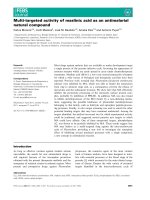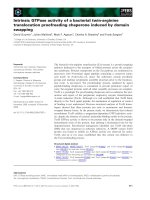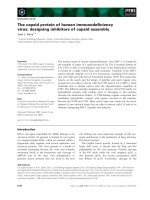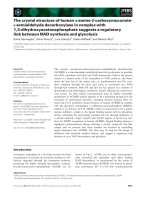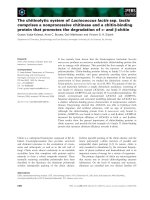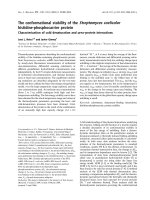báo cáo khoa học: "The anti-myeloma activity of a novel purine scaffold HSP90 inhibitor PU-H71 is via inhibition of both HSP90A and HSP90B1" docx
Bạn đang xem bản rút gọn của tài liệu. Xem và tải ngay bản đầy đủ của tài liệu tại đây (2 MB, 8 trang )
RESEA R C H Open Access
The anti-myeloma activity of a novel purine
scaffold HSP90 inhibitor PU-H71 is via inhibition
of both HSP90A and HSP90B1
Saad Z Usmani
1*
, Robert D Bona
2
, Gabriela Chiosis
3
, Zihai Li
4*
Abstract
Background: Heat shock protein 90 (HSP90) inhibitors have emerged as a promising class of anti-cancer drugs in
both solid and hematologic malignancies. The HSP90 family includes the cytosolic HSP90 (HSP90AA1), the ER
paralogue gp96 (HSP90B1) and the mitochondrial member TRAP1 (HSP90L). We evaluated the in vitro anti-tumor
activity and mechanism of action of PU-H71, a novel purine scaffold HSP90 inhibitor in human multiple myeloma
cell lines.
Methods: Multiple human myeloma cell lines including cells that are resistant to corticosteroids and bortezimab
were treated with PU-H71, followed by analysis of cell viability, cell cycle progression and apoptosis, by flow
cytometry and caspase 3 immunoblot. Induction of unfolded protein response was studied by XBP-1 s
immunoblot. The role of gp96 was further assessed by small hairpin RNA knockdown of gp96 before treatment
with PU-H71.
Results: PU-H71 has potent in vitro anti-myeloma activity in both drug-sensitive and drug-resistant cell lines.
PU-H71 activates the un folded protein response and induces caspase-dependent apoptosis. Th e stable gp96
knockdown human myeloma cell line was found to be more resistant to PU-H71 and other HSP90 inhibitors
including 17-AAG and 17-DMAG, even though these cells are more sensitive to conventional anti-myeloma drugs.
Conclusion: We conclude that PU-H71 is a promising drug for the treatment of myeloma. Our finding further
suggests that PU-H71 and the geldanamycin analogues work in part by inhibiting the endoplasmic reticulum gp96
along with the cytosolic HSP90.
Introduction
Multiple myeloma is a clonal plasma cell malignancy
accompanied by characteristic bone lesions, cytope nias,
renal insufficiency and immune deficiency. The last dec-
ade has witnessed significant advances in anti-myeloma
therapy with median survival extending from 2-3 years
to over 7 years for patients younger than 50 years [1].
Heat shock protein 90 (HSP90) inhibitors are an emer-
ging class of targeted agents in cancer therapy. HSP90
inhibition would make intuitive sense as anti-tumor ther-
apy in cell types that depend on sustained protein
homeostasis for their survival. A number of HSP90 inhibi-
tors have demonstrated anti-myeloma activity in pre-
clinical studies and at least three compounds have been
evaluated in Phase I trials for relapsed/refractory myeloma
[2-5] . PU-H71 is a novel purine scaffold HSP90 inhibitor
that has shown pre-clinical activity in triple negative breast
cancer [6], Bcl6 dependent lymphom a [7], hepatocellular
carcinoma [8] and myeloproliferative disorders [9].
HSP90 family of proteins are ubiquitous molecular cha-
perones that are involved in foldi ng, activation, matura-
tion and assembly o f many proteins (referred to as
HSP90 client proteins or HSP90 clientele) that include
essential mediators of signal transduction and cell cycle
progression [10]. The mammalian HSP90 family mem-
bers include the cytosolic HSP90, the HSP90 paralogue
gp96 (also known as grp94, endoplasmin, HSP90B1) in
the endoplasmic reticulum (ER) and the mitochondrial
* Correspondence: ;
1
Myeloma Institute for Research & Therapy, University of Arkansas for
Medical Sciences, Little Rock, AR, USA
4
Department of Immunobiology & Cancer Immunology, Hollings Cancer
Center, Medical University of South Carolina, Charleston, SC, USA
Full list of author information is available at the end of the article
Usmani et al. Journal of Hematology & Oncology 2010, 3:40
/>JOURNAL OF HEMATOLOGY
& ONCOLOGY
© 2010 Usmani et al; licensee BioMed Central Ltd. This is an Open Access article distribute d under the terms of the Creative Commons
Attribution License ( which permits u nrestricted use, distribution, and reprod uction in
any medium, prov ided the original work is properly cited.
protein TRAP1. There have been recent significant pro-
gresses in the understanding of both the structure and
function of gp96. It serves a s an obligate master chape r-
one for multiple Toll-like receptors [11,12] and integrins
[13,14], neither of which could function properly in the
absence of gp96. More recently, gp96 has been observed
to play a critical role in lymphopoeisis in that deletion of
gp96 leads to a transitional block from pro-B to pre-B
cells and the inability of thymocytes to develop beyond
the CD4(-)CD8(-) stage [14]. gp96 also maintains the
fidelity of the endoplasmic reticulum protein synthesis by
mediating the unfolded protein response (UPR) [15]. It
shares ~50% homology at the amino acid level with its
cytosolic HSP90 paralogue, with a similar domain organi-
zati on consisting of an N-termin al ATP-binding domain,
a charged middle domain and a C -terminal homodimeri-
zation domain [16].
The unfolded protein response (UPR) is a highly con-
served eukaryotic protein homeostasis mechanism that
is especially important for secretory cell types (e.g.,
hepatocytes, plasma cells, etc.) [17]. In response to cellu-
lar stress, UPR leads to increased ER chaperones such as
grp78, gp96 and calreticulin to deal with the increased
load of unfolded and nascent proteins in the ER. In
response to sustained cellular stress, the UPR activates
the apoptotic pathway. It has been previously demon-
strated that, a geldanamycin derived HSP90 inhibitor,
can a ctivate the unfolded protein response in myeloma
cells [18].
Herein, we evaluated the in vitro anti-myeloma activity
of PU-H71, a novel purine scaffold HSP90 inhibitor. We
also determined if the anti-tumor activity of HSP90
inhibitors is achieved via targeting both cyt osolic HSP90
and the endoplasmic reticulum HSP90 paralogue gp96.
Materials and methods
Cell lines
We studied a panel of previously established human
MM cell lines and sublines (MM-1 S, MM-1R, RPMI-
8226/S, RPMI-8226/Dox40, INA-6, NCI-H929, OPM-1
U266). The dexamethasone (Dex)-sensitive parental line
MM-1 S and its Dex-resistant subline MM-1R cells
were kindly provided by Dr. Steven Rosen (Northwes-
tern University, Chicago, IL); the chemo-resistant sub-
line RPMI-8226/Dox40 (doxorubicin-resistant) cells
were provided by Dr. William Dalton (Lee Moffitt Can-
cer Center, Tampa, FL); OPM-1cells were provided by
Dr. Brad T hompson; INA-6 cells were provided by
Renate Burger (University of Erlangen-Nuernberg, Ger-
many); RPMI-8226/S, NCI-H929 and U266 cells were
purchased from American Type Cell Culture (ATCC).
All cells were cultured in RPMI 1640 medium (Life
Technologies, Grand Island, NY) supplemented with
10% fetal bovine serum, L-glutamine, penicillin, and
streptomycin (Life Technologies), except for INA-6 and
XG-1 cells, which were cultured in media supplemented
with 20% fetal bovine serum (FBS) and 2.5 ng/mL of
human recombinant IL-6.
Ex vivo drug sensitivity assays
Cell survival of PU-H71 treated cells (1 × 10
5
cells plated
in triplicate) was examined using trypan blue staining fol-
lowed by cell count for viability using a hemocytometer.
HSP90B1 (gp96) knockdown by short hairpin RNA
(shRNA)
Empty vector (EV) and gp96 pLKO shRNA vectors were
obtained from Open Biosystems (Huntsville, AL).
Recombinant lentivirus was produced by transient trans-
fection of 293T cells following a standard protocol [12].
After 48 hours, myeloma cells were incubated with cul-
ture supernatants from 293T cells containing crude virus.
Spin infection was achieved by centrifugation at 1900 g
for 1.5 h at 32°C to facilitate viral transduction. Cells
were then fed with fresh media and allowed to recover
for 48-72 hours before being subjected to puromycin
selection.
Reagents
Most antibodies (Abs) used for flow cytometry were
obtained from Biolegend (Mountain View, CA),
eBioscience (San Diego, CA), except Abs against p-Akt,
p-IKB, and p-eIF2a (Cell Signaling Technology, Danvers,
MA) and HSP90b1 (Stressgen, Victoria, BC). The active
geldanamycin analog 17-allylamino-17-demethoxy-gelda-
namcyin (17-AAG, NSC 330507) was obtained from the
Drug Synthesis and Chemistry Branch, Developmental
Therapeutics Program, National Cancer Institute
(Bethesda, MD); Bortezomib was purchased from LC
Laboratories (Woburn, MA). All other chemicals were
obtained from Sigma-Aldrich (St Louis, MO).
Flow cytometry
Ab staining, flow cytometry instrumentation, and d ata
analysis were performed essentially as described without
significant modifications [13]. In brief, sing le-cell suspen-
sions were made, washed, and blocked with staining buf-
fer containing serum. Cells were then incubated with
primary Ab, followed by incubation with fluorochrome-
labeled secondary Ab. Immediately before instrumenta-
tion, propidium iodide (PI) was added to stain and
exclude dead cells. Cells w ere finally acquired with a
FACSCa libur (BD Biosciences). For intracellular staining,
cells were fixed and permeabilized using ice-cold 70%
EtOH. Nonspecific binding was blocked with 10% normal
goat serum. Fluoresc ence-activated cell sorter data were
analyzed on FlowJo software (TreeStar). For DNA con-
tent by PI staining, cells were fixed and permeabilized
Usmani et al. Journal of Hematology & Oncology 2010, 3:40
/>Page 2 of 8
with 70% ice cold ethanol followed by PBS wash. Cells
were then incubated for 30 minutes with 50 ml of
RNAaseA(1mg/mlstock,Sigma)and50mlofPIsolu-
tion (1 mg/ml, Sigma) before being analyzed on FACSCa-
libur (BD Biosciences).
Immunoblot
Myeloma lysates were prepared with radio immunopreci-
pitation assay (RIPA) lysis buffer (0.01 M sodium phos-
phate (pH 7.2), 150 mM NaCl, 2 mM EDTA, 1%
Nonidet P-40, 1% sodium deoxycholate, and 0.1% SDS)
and quantitated by Bradford protein assay (Bio-Rad).
25-50 micrograms of total lysate were denatured by
boiling for 5 min in the presence of 0.1 M DTT and
SDS-loading buffer, followed by resolution on a 10%
SDS-PAGE and transfer to a polyvinylidene difluoride
membrane. After blocking, membranes were blotted
with appropriate primary and horseradish peroxidase-
conjugated secondary Abs and developed with chemilu-
minescent substrate (Pierce Chemical). b-actin was
blotted (AC-74; Sigma-Aldrich) as a loading control.
Statistical analysis
Error bars represent the standard error of the arithmetic
mean (SEM). Student t test and ANOVA were used for
statistical analysis. Values of P less than 0.05 were con-
sidered to represent statistically significant differences.
Results
PU-H71 has potent in vitro anti-myeloma activity
To determine the anti-myeloma activ ity of this new clas s
of HSP90 inhibitor, we exposed a panel of human mye-
loma cell lines to increasing molar concentrations of
PU-H71 (Figures 1. We found that PU-H71 has potent
Figure 1 In vitro anti-myeloma activity of PU-H71. (A) Drug-sensitive human myeloma cell lines were treated with PU-H71 for 24 hours
followed by cell viability analysis. (B) Same as (A) except that drug-resistant cell lines are used. (C) Synergistic effects of PU-H71 (100 nM) with
melphalan (1 μM), dexamethasone (1 μM), thalidomide (1 μM) and bortezomib (100 nM) on INA-6 cells treated for 24 hours. * p < 0.05
Usmani et al. Journal of Hematology & Oncology 2010, 3:40
/>Page 3 of 8
anti-tumor effects in both drug-sensitive (MM-1 S,
RPMI-8226/S, INA-6, NCI-H929 and U266) and drug-
resistant (MM-1R, RPMI-8226/Dox40, OPM-1) human
myeloma cell lines (HMCLs). The observed myeloma cell
death was dose-dependent and reproducible. The half
maximal concentration of PU-H71 to exert anti-myeloma
killing effect (IC50) was in the range of 100 nM to 300
nM at 24 hours. These IC50 values are comparable to the
published data in breast cancer [6] and Jak2/MPL mutant
cells (~100 nM) [9], but significantly less than Bcl-6-
dependent lymphoma cells ( > 1 μM) [7]. Importantly,
PU-H71 also demonstrated pronounced in vitro synergy
with other anti-myeloma drugs including dexamethasone,
melphalan, thalidomide and bortezomib (Figure 1C).
PU-H71 causes cell cycle arrest in the G1-S phase
We studied the effect of PU-H71 on cell cycle progres-
sion in the human myeloma cell lines at 24 hours of
drug exposure. We found that PU-H71 treatment led to
a decline in the proportions of cells in the G2-M p hase
demonstrated by flow cytometric analysis of DNA con-
tent (Figure 2A). This was accompanied by the reduc-
tion in the cyclin D1 expression at the protein level
(Figure 2B), measured by flow cytometry after intracellu-
lar stain. These results suggest strongly that PU-H71
inhibits cell cycle progression.
PU-H71 activates the unfolded protein response and
induces caspase dependent apoptosis
We exposed the dexamethasone-resistant cell line
MM.1R to increasing concentrations of PU-H71 to eval-
uate the unfolded protein response and the mechanism
of apoptosis. PU-H71 upregulates spliced XBP1 consis-
tent with activation of the unfolded protein response
[17] (Figure 3A). It was observed that PU-H71 treatment
resulted in accumulation of the cleaved caspase 3 in a
dose-dependent manner (Figure 3B) . This was accompa-
nied by increase in cleavage of poly(ADP-ribose) poly-
merase (PARP), as a downstream consequence of
activated caspase-3 [19]. In combination, these observa-
tions suggest that PU-H71 can cause myeloma cell
death by activation of the unfolded protein response
and the caspase-dependent apoptotic pathway.
PU-H71 has decreased anti-myeloma activity in the gp96
knockdown human myeloma cells
To determine if PU-H71 exerts its anti-myeloma activity
is dependent on targeting gp96, we stably knocked
down gp96 from RPMI-8226 using a lentiviral vector-
based shRNA vector (Figure 4A). Consistent with the
roles of gp96 in chaperoning integrins, the knockdown
cells expressed significantly less surface integrins includ-
ing a4, aLandaV integrins, comparing with cells trea-
ted with empty vector (Figure 4B). Upon exposing these
cells to increasing concentrations of PU-H71, the gp96
knockdown cells demonstrated increased resistance to
PU-H71, as well as to two other pan-HSP90 inhibitors:
geldanamycin analogues 17-AAG and 17-DMAG (Figure
5A-C). Interestingly, the sensitivity to dexamathasone-
mediated anti-myeloma effect was also reduced with
gp96 knockdown (Figure 5D). To rule out that gp96
knockdown caused general drug resistance, we also trea-
ted cells with increasing doses of melphalan, doxorubi-
cin, bortezomib and thalidomide (Figure 5. We found
that the gp96 knockdown cells were more susceptible
than control cells to these agents. Taken together, these
observations suggest that PU-H71 and the geldanamycin
Figure 2 Effect of PU-H71 on cell cycle. (A) DNA content analysis
by flow cytometry performed on MM.1R and RPMI-8226/DOX40
cells exposed to PU-H71 (100 nM) for 24 hours. (B) Intracellular
staining for cyclin D1 in MM.1R cells after 24-hour treatment with
PU-H71 (100 nM).
Usmani et al. Journal of Hematology & Oncology 2010, 3:40
/>Page 4 of 8
analogues exert their anti-tumor activity via targeting
both cytosolic HSP90 and gp96.
Discussion
The cytosolic HSP90 has a diverse list of client proteins
that participate in pathways li nked to all six hallmarks
of cancer development pro posed by Weinberg [5,20].
A number o f ATP-competitive inhibitors, including the
geldanamycin derived 17-AAG, 17-DMAG and IPI-504,
have been developed and investigated for the treatment
of both solid and hematologic malignancies. The gelda-
namycin derivatives have demonstrated significant dose
limiting non-hematopoietic toxicities, limiting their clin-
ical efficacy [5]. This has led to development of purine
scaffold, non-benzoquinone HSP90 inhibitors [21]. Pre-
clinical studies with PU-H71intriple-negativebreast
cancer [6] and diffuse large B-cell lymphoma [7] have
demonstrated considerable efficacy with limited hemato-
poietic or non-hematopoietic toxicity. However, the effi-
cacy of PU-H71 has not been investigated in multiple
myeloma. We exposed a panel of human multiple mye-
loma cell lines to escalating doses of PU-H71 and dis-
covered it to be highly active in vitro. The anti-tumor
activity was observed in both drug-sensitive and drug-
resistant cell lines. PU-H71 showed c omparable anti-
myeloma activ ity in IL-6 dependent cell line INA-6 and
the other IL-6 independent cell lines. PU-H71 also
demonstrated in vitro synergy with other conventional
anti-myeloma drugs. Mechanistically, we found that
PU-H71 led to activation of the UPR and apoptosis via
the caspase-dependent pathway.
The past decade brought forth valuable insights on the
endoplasmic reticulum HSP90 family member, i.e., gp96
(HSP90B1, grp94). On the one hand, because of the
nature of gp96 to chaperone antigenic peptides to anti-
gen-cross-presentation pathway [22], vaccinations with
purified tumor-derived gp96-peptide c omplex have
demonstrated promising pre-clinical and clinical results
in a number of malignancies, including multiple mye-
loma [23]. On the other hand, endogenous gp96 is the
master chaperone for most integrins (including a4, aV
and aL) [14] and is one of the key mediators in the
unfolded protein respons e. gp96 blockade, therefore, can
(a) disrupt the integrin-dependent cell adhesion mediated
drug resistance in multiple myeloma; (b) upset protein
homeostasis and compromi setheefficiencyofthe
unfolded protein response. In this study, we established a
stable gp96 knockdown human myeloma cell line to eval-
uate the in vitro activity of anti-myeloma drugs in the
absence of gp96. We found, as predicted, that gp96
knockdown cells were more sensitive to bortezomib
which further compromises protein homeostasis. gp96
knockdown cells were also more susceptive to killing
mediated by genotoxic drug melphal an and doxorubicin,
and to thalidomide that has a yet not fully understood
mechanism of action. The anti-myeloma activity of PU-
H71 and the geldanamycin analogues (17-AAG,
17-DMAG), which are all pan-HSP90 inhibitors, was,
however, significantly reduced in the absence of gp96.
This data suggests that HSP90 inhibitors exert their
acute cytotoxic activity via inhibiting not only cytosolic
HSP90, but also gp96. The interaction between HSP90
inhibitors and gp96 might trigger apoptosis that is depen-
dent on the unfolded protein response pathway. In the
absence or low level of gp96 in the chronic setting (as in
the case of shRNA knockdown), an unknown compensa-
tory mechanism might develop to overcome the defective
protein quality control associated with gp96 loss. Such a
mechanism might render cells less dependent on even
the cytosolic HSP90. Interestingly, dexamethasone also
had reduced efficacy in the absence of gp96, suggesting
that TLR-dependent signaling might participate in the
glucocorticoid-mediated apoptosis. Further study is
necessary to clarify this point.
Conclusions
In summary, our study highlights the in vitro anti-
myeloma activity of PU-H71, a novel purine scaffold
HSP90 inhibitor. We also demonstrated t hat the anti-
myeloma effect of HSP90 inhibitors including PU-H71
is via targeting both cytosolic HSP90 and the ER HSP
gp96. A phase I stu dy to test the clinical utility of PU-
H71 in patients with refractory myeloma is warranted.
Figure 3 Effect of PU-H71 o n the unfolded protein response
(UPR) and apoptosis. (A) Immunoblot of XBP1 s on 24 hour
treated RPMI-8226/DOX40 cells. (B) Immunoblot on 24-hour treated
MM.1R cell lysate for cleaved caspase 3 and cleaved PARP (cPARP).
Usmani et al. Journal of Hematology & Oncology 2010, 3:40
/>Page 5 of 8
Acknowledgements
We are indebted to all the investigators (cited in the paper) who generously
provided valuable reagents to us for the study. We are grateful to Drs. Bei
Liu, Mathew Staron and Feng Hong for technical guidance, and to Shuang
Wu and Crystal Morales for stimulating discussion during the study. This
study was supported by a Pilot Multiple Myeloma Fund from the Neag
Comprehensive Cancer Center, University of Connecticut (to SZU) and grants
from the Leukemia and Lymphoma Society and National Institutes of Health
(to ZL).
Author details
1
Myeloma Institute for Research & Therapy, University of Arkansas for
Medical Sciences, Little Rock, AR, USA.
2
Carole and Ray Neag Comprehensive
Cancer Center, Lea’s Center for Hematologic Disorders, University of
Connecticut Health Center, Farmington, CT, USA.
3
Department of Molecular
Pharmacology & Chemistry, Memorial Sloan Kettering Cancer Center, New
York, NY, USA.
4
Department of Immunobiology & Cancer Immunology,
Hollings Cancer Center, Medical University of South Carolina, Charleston, SC,
USA.
Figure 4 Generation of gp96 knockdown RPMI-8226 cell line. (A) Immunoblot analysis of gp96 after stable transduction with empty vector
(EV) or gp96 shRNA lentiviral vector (gp96 KD). (B) Loss of surface integrins expression (open histogram) by flow cytometry in gp96 KD cells.
Shaded histograms represent background staining with isotype-control antibody. THP-1 cells were used for positive control for this experiment.
Usmani et al. Journal of Hematology & Oncology 2010, 3:40
/>Page 6 of 8
Authors’ contributions
SZU and ZL conceived, designed and implemented the study, and drafted
the manuscript.
RB and GC participated in the implementation of the study, and the
acquisition, analysis and interpretation of data.
All authors have read and approved the final manuscript.
Competing interests
The authors declare that they have no competing interests.
Received: 6 October 2010 Accepted: 26 October 2010
Published: 26 October 2010
Figure 5 Anti-myeloma effects of drugs against gp96 knockdown cell line. (A) PU-H71. (B) 17-AAG. (C) 17-DMAG. (D) Dexamethasone. (E)
Bortezomib. (F) Melphalan. (G) Doxorubicin. (H) Thalidomide. All drug treatment was for 24 hours. * p < 0.05.
Usmani et al. Journal of Hematology & Oncology 2010, 3:40
/>Page 7 of 8
References
1. Brenner H, Gondos A, Pulte D: Recent major improvement in long-term
survival of younger patients with multiple myeloma. Blood 2008,
111:2521-2526.
2. Richardson PG, Chanan-Khan AA, Alsina M, Albitar M, Berman D, Messina M,
Mitsiades CS, Anderson KC: Tanespimycin monotherapy in relapsed
multiple myeloma: results of a phase 1 dose-escalation study. Br J
Haematol 150:438-445.
3. Nakashima T, Ishii T, Tagaya H, Seike T, Nakagawa H, Kanda Y, Akinaga S,
Soga S, Shiotsu Y: New molecular and biological mechanism of
antitumor activities of KW-2478, a novel nonansamycin heat shock
protein 90 inhibitor, in multiple myeloma cells. Clin Cancer Res
16:2792-2802.
4. Kaiser M, Lamottke B, Mieth M, Jensen MR, Quadt C, Garcia-Echeverria C,
Atadja P, Heider U, von Metzler I, Turkmen S, Sezer O: Synergistic action of
the novel HSP90 inhibitor NVP-AUY922 with histone deacetylase
inhibitors, melphalan, or doxorubicin in multiple myeloma. Eur J
Haematol 84:337-344.
5. Usmani SZ, Bona R, Li Z: 17 AAG for HSP90 Inhibition in Cancer - From
Bench to Bedside. Curr Mol Med 2009, 9:654-664.
6. Caldas-Lopes E, Cerchietti L, Ahn JH, Clement CC, Robles AI, Rodina A,
Moulick K, Taldone T, Gozman A, Guo Y, et al: Hsp90 inhibitor PU-H71, a
multimodal inhibitor of malignancy, induces complete responses in
triple-negative breast cancer models. Proc Natl Acad Sci USA 2009,
106:8368-8373.
7. Cerchietti LC, Lopes EC, Yang SN, Hatzi K, Bunting KL, Tsikitas LA, Mallik A,
Robles AI, Walling J, Varticovski L, et al: A purine scaffold Hsp90 inhibitor
destabilizes BCL-6 and has specific antitumor activity in BCL-6-
dependent B cell lymphomas. Nat Med 2009, 15:1369-1376.
8. Breinig M, Caldas-Lopes E, Goeppert B, Malz M, Rieker R, Bergmann F,
Schirmacher P, Mayer M, Chiosis G, Kern MA: Targeting heat shock protein
90 with non-quinone inhibitors: a novel chemotherapeutic approach in
human hepatocellular carcinoma. Hepatology 2009, 50:102-112.
9. Marubayashi S, Koppikar P, Taldone T, Abdel-Wahab O, West N, Bhagwat N,
Caldas-Lopes E, Ross KN, Gonen M, Gozman A, et al: HSP90 is a
therapeutic target in JAK2-dependent myeloproliferative neoplasms in
mice and humans. J Clin Invest 2010, 120:3578-93.
10. Whitesell L, Lindquist SL: HSP90 and the chaperoning of cancer. Nat Rev
Cancer 2005, 5:761-772.
11. Yang Y, Liu B, Dai J, Srivastava PK, Zammit DJ, Lefrancois L, Li Z: Heat shock
protein gp96 is a master chaperone for toll-like receptors and is
important in the innate function of macrophages. Immunity 2007,
26:215-226.
12. Liu B, Yang Y, Qiu Z, Staron M, Hong F, Li Y, Wu S, Hao B, Bona R, Han D,
Li Z: Folding of Toll-like receptors by the HSP90 paralogue gp96 requires
a substrate-specific cochaperone. Nat Commun 2010.
13. Liu B, Li Z: Endoplasmic reticulum HSP90b1 (gp96, grp94) optimizes B-
cell function via chaperoning integrin and TLR but not immunoglobulin.
Blood 2008, 112
:1223-1230.
14. Staron M, Yang Y, Liu B, Li J, Shen Y, Zuniga-Pflucker JC, Aguila HL,
Goldschneider I, Li Z: gp96, an endoplasmic reticulum master chaperone
for integrins and Toll-like receptors, selectively regulates early T and B
lymphopoiesis. Blood 2010, 115:2380-2390.
15. Christianson JC, Shaler TA, Tyler RE, Kopito RR: OS-9 and GRP94 deliver
mutant alpha1-antitrypsin to the Hrd1-SEL1L ubiquitin ligase complex
for ERAD. Nat Cell Biol 2008, 10:272-282.
16. Dollins DE, Warren JJ, Immormino RM, Gewirth DT: Structures of GRP94-
nucleotide complexes reveal mechanistic differences between the hsp90
chaperones. Mol Cell 2007, 28:41-56.
17. Ron D, Walter P: Signal integration in the endoplasmic reticulum
unfolded protein response. Nat Rev Mol Cell Biol 2007, 8:519-529.
18. Davenport EL, Moore HE, Dunlop AS, Sharp SY, Workman P, Morgan GJ,
Davies FE: Heat shock protein inhibition is associated with activation of
the unfolded protein response pathway in myeloma plasma cells. Blood
2007, 110:2641-2649.
19. Simbulan-Rosenthal CM, Rosenthal DS, Iyer S, Boulares AH, Smulson ME:
Transient poly(ADP-ribosyl)ation of nuclear proteins and role of poly
(ADP-ribose) polymerase in the early stages of apoptosis. J Biol Chem
1998, 273:13703-13712.
20. Hanahan D, Weinberg RA: The hallmarks of cancer. Cell 2000, 100:57-70.
21. Chiosis G, Caldas Lopes E, Solit D: Heat shock protein-90 inhibitors: a
chronicle from geldanamycin to today’s agents. Curr Opin Investig Drugs
2006, 7:534-541.
22. Binder RJ, Srivastava PK: Peptides chaperoned by heat-shock proteins are
a necessary and sufficient source of antigen in the cross-priming of CD8
+ T cells. Nat Immunol 2005, 6:593-599.
23. Qian J, Hong S, Wang S, Zhang L, Sun L, Wang M, Yang J, Kwak LW, Hou J,
Yi Q: Myeloma cell line-derived, pooled heat shock proteins as a
universal vaccine for immunotherapy of multiple myeloma. Blood 2009,
114:3880-3889.
doi:10.1186/1756-8722-3-40
Cite this article as: Usmani et al.: The anti-myeloma activity of a novel
purine scaffold HSP90 inhibitor PU-H71 is via inhibition of both HSP90A
and HSP90B1. Journal of Hematology & Oncology 2010 3:40.
Submit your next manuscript to BioMed Central
and take full advantage of:
• Convenient online submission
• Thorough peer review
• No space constraints or color figure charges
• Immediate publication on acceptance
• Inclusion in PubMed, CAS, Scopus and Google Scholar
• Research which is freely available for redistribution
Submit your manuscript at
www.biomedcentral.com/submit
Usmani et al. Journal of Hematology & Oncology 2010, 3:40
/>Page 8 of 8
